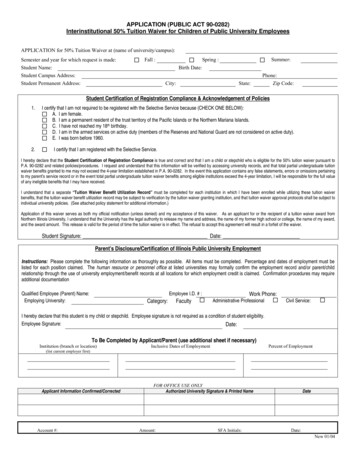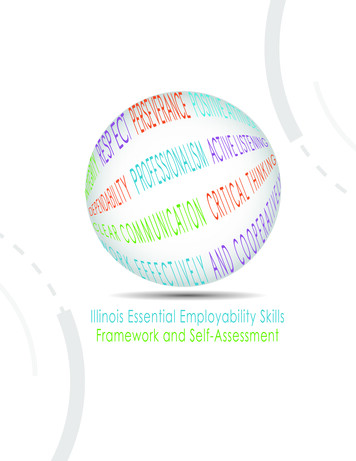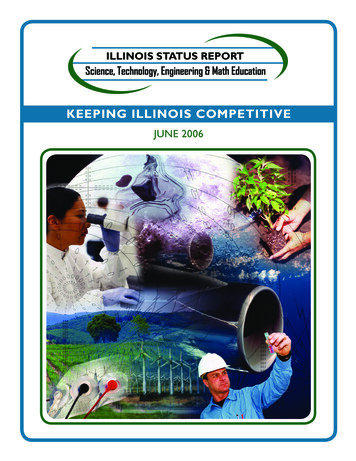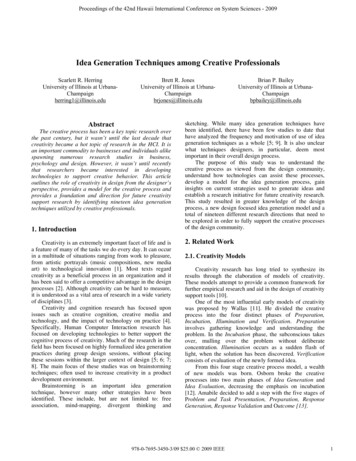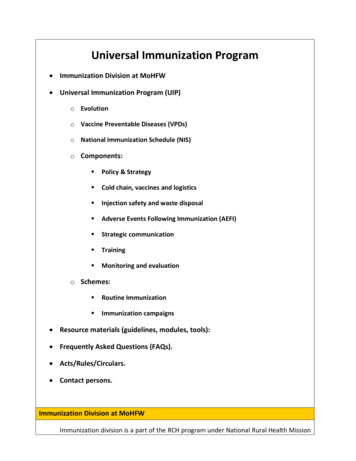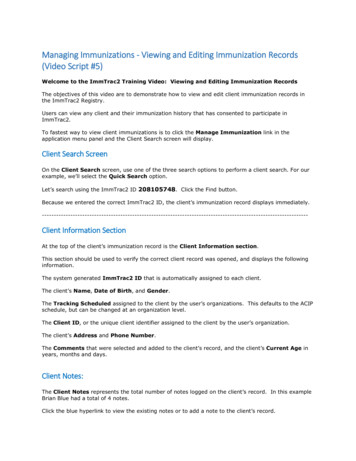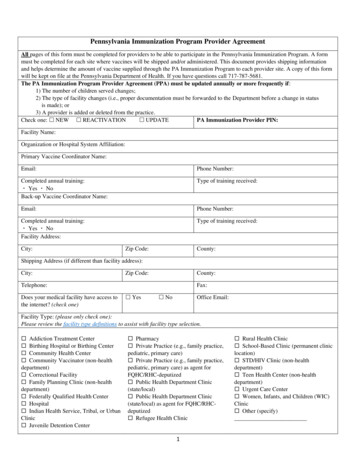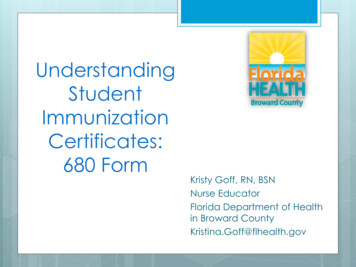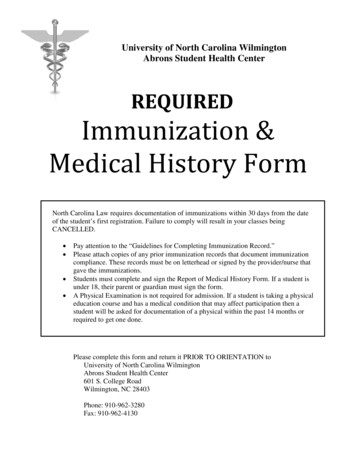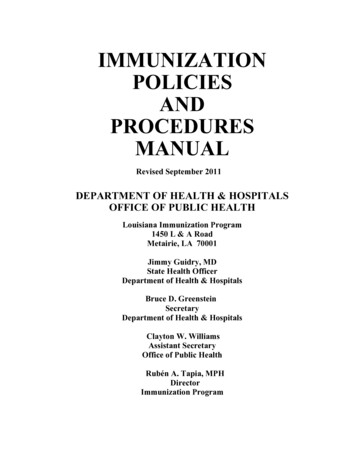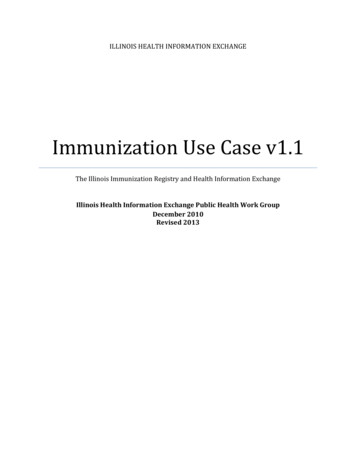
Transcription
ILLINOIS HEALTH INFORMATION EXCHANGEImmunization Use Case v1.1The Illinois Immunization Registry and Health Information ExchangeIllinois Health Information Exchange Public Health Work GroupDecember 2010Revised 2013
Immunization Use Case v1.1December 2010Table of ve Summary .3Introduction .5Scope . 6Use Case Stakeholders . .8Issues and Obstacles 10Use Case Pre-Conditions. . .10Use Case Post-Conditions. 11Detailed Scenarios/Technical Specifications. 12Information Exchange 14Dataset Considerations .15Validation and Certification .16Appendix A . 17Page 2
Immunization Use Case v1.1December 20101.0Executive SummaryThis Use Case is a product of the Public Health Work Group (PHWG) of the Illinois HealthInformation Exchange (HIE) Advisory Committee. The Illinois HIE Advisory Committeewas constituted as the diverse public healthcare stakeholder body providing input andrecommendations on the creation of the Illinois HIE Authority (“the Authority”) as theIllinois vehicle for designing and implementing electronic health information exchange inIllinois. The establishment of the Authority marks the formal transition of the work of theHIE Advisory Committee and the Work Groups into alignment with the provisions ofIllinois Public Act 096-1331, the Illinois Health Information Exchange and Technology Act.Generally, the mission of the PHWG is to provide guidance and recommendations to theHIE Advisory Committee or its successors on the exchange of data relevant to public healthbetween HIEs that operate in Illinois and Illinois public health agencies. This will beadvanced byencouraging the adoption of electronic health records (EHRs) and the use of healthinformation technology (health IT) to improve both individual and populationhealth status and public health outcomes;assuring standards-based interoperability and workable data sharing between thepublic health system and HIEs in Illinois, including the Illinois HIE, local exchanges,and institution-based EHR systems;demonstrating and documenting the mutual benefit to public health and healthcareproviders in the development of the Illinois HIE;assuring policy compatibility with the goals of public health for the use of individualand population health data;communicating to and educating the public health system about the value andapplications of the Illinois HIE and promoting participation in the HIE by state andlocal health departments and the broader public health community; andpromoting the identification of resources for public health to fully participate in HIEplanning.The Illinois Office of Health Information Technology (OHIT) will provide administrativeand implementation support to the Authority as it moves forward with the development ofthe Illinois HIE. It is the intention of OHIT to release a request for proposals in early 2011that will detail the requirements for the initial design of the Illinois HIE. The purpose ofthis Use Case is to document and describe the current state of information flowsregarding immunizations in Illinois, and to document and describe the ideal state ina future system that includes expanded electronic health information systems andPage 3
Immunization Use Case v1.1December 2010HIE. The PHWG expects that the Use Case will be one of many inputs into the upcomingRFP process, and will be a scored element of the process to award the contract to designand build the Illinois HIE.Making a priority of integrating Illinois’ immunization registry in Illinois’ HIE planning isjustified by its specific inclusion in the federal rules for Meaningful Use under the EHRIncentive Programs, including the criterion for “electronic submission to immunizationregistries”. Because the Illinois immunization registry is already employing federal healthinformation technology funding to upgrade the registry, now is the right time to work tointegrate it with the emerging HIE development plans. Additionally, supporting bidirectional communications between the registry and healthcare providers has thefollowing benefits:Reduces death, morbidity, disabilityEnables stakeholders to meet Meaningful UseEnriches clinical records to enhance decision support for providersIncreases patient safety and quality of careIncreases system efficiency, reduces redundancy and repetition of servicesWhich in turn decreases overall cost of providing immunization servicesResults in a more complete description of population-level health outcomesWhich in turn allows for better allocation of public resources to support moreeffective immunization practicesIncreases capacity to prevent vaccine-preventable diseasesProvides a structural model for other governmental public health systems to beintegrated with EHR/HIEThe PHWG Immunization Use Case addresses several aspects of immunization information,including: immunization status for specific populations as well as the general population;the automated integration of electronic immunization data into Illinois’ immunizationregistry and case management databases; vaccine supply management and the automatedintegration of immunization and vaccine information into supply chain and productmanagement tracking functions; and automated functionalities related to Illinois statutoryrequirements regarding elementary school attendance.This Use Case is divided into the following Sections:2.03.04.05.0IntroductionScopeUse Case StakeholdersIssues and ObstaclesPage 4
Immunization Use Case v1.1December 20106.07.08.09.010.011.0Use Case Pre-ConditionsUse Case Post-ConditionsDetailed Scenarios/Technical SpecificationsInformation ExchangeDataset ConsiderationsValidation and Certification2.0IntroductionVaccines save lives routinely and in times of outbreaks – they are one of the ten greatPublic Health Achievements of the last century. From a variety of perspectives, includingmedical and financial, the public benefits when the whole population is vaccinated againstdisease are immense; providing individual and population level protection against illnessand death caused by infectious diseases. Simplifying the reporting, tracking, andmonitoring of immunizations in the population through use of a registry that isinteroperable with the clinical EHR, will pay off in helping to ensure that appropriateimmunizations are administered to everyone.Immunizations are a proxy measure for the overall health of the population; the idea beingthat if people are appropriately immunized they are also receiving other preventive andprimary care. As such they are an important quality indicator for public healthdepartments, health care organizations, and consumers to monitor for continuousimprovement.The PHWG chose to provide a clear pathway for interoperability between clinical providersand the Illinois immunization registry, the Illinois Comprehensive AutomatedImmunization Registry Exchange (I-CARE). The secure exchange of this data will allowIllinois to increase the number of children and adults participating in the immunizationregistry, eliminate double entry of immunization data by providers, reduce the risk of careinterruption, and ensure widespread use of the registry to establish greater accuracy onIllinois and national immunization levels. Eventually the immunization registry maybecome part of the public health node on the Illinois HIE.I-CARE is an immunization registry application developed by the Illinois Department ofPublic Health (IDPH), allowing heath care providers to share immunization records ofIllinois residents. I-CARE is designed to help providers collect, store, analyze, and reporttheir patients’ immunization data as well as access patient records for information aboutimmunizations administered outside their practices. I-CARE currently storesPage 5
Immunization Use Case v1.1December 2010immunization information on approximately 4 million patients and contains nearly 40million records.1Among the functionality available to I-CARE users is the capability to: forecastimmunization due dates; prevent duplicate immunizations; follow CDC’s immunizationschedule for children and adults; produce a health record and pre-printed school physicalforms; record patient contraindications, adverse reactions, and immunities; track vaccineinventory; collect patient demographic data and insurance eligibility; maintain runningprogress notes; and schedule appointments as well as track and notify patients ofupcoming due dates. I-CARE has also incorporated additional data fields to track andrecord body mass index, height and weight, blood pressure, and blood lead screenings.I-CARE can accept data from Cornerstone (the statewide data management informationsystem developed to effectively measure health outcomes and facilitate the integration ofcommunity maternal and child health services provided to Illinois residents by the IllinoisDepartment of Human Services) through daily batch flat file transfers. Data entereddirectly into the I-CARE web-portal is available in real-time. IDPH is currently working withproviders to enable secure messaging directly between a provider’s EHR and I-CARE. ICARE is able to accept HL7 data, in versions 2.31 and 2.51, from outside sources and isprepared to accept batch data through a secure STP site, which it will use to populate theregistry. IDPH anticipates implementing 2-way real time patient data exchange in early2011.This immunization registry Use Case focuses on the needs of consumers, clinicians,registries, and public health carrying out routine care activities associated withimmunizations. This Use Case also recognizes that the technical infrastructure for theimmunization registry supports routine immunizations by governmental public health andother healthcare providers as well as emergency situations arising from outbreaks,epidemics and natural disasters. This Use Case does not address all the operationalpossibilities of the immunization registry – but will focus on universality, the functionalityof providers receiving real time feedback regarding immunization status, reminder recalls,vaccine and drug administration reporting, immunization monitoring, vaccine and druginventory reporting, and reporting and notification of adverse events.3.0ScopeSince widespread adoption of the EHR and meaningful use of that record is the goal of thenational and statewide health IT agenda, this Use Case for immunization data exchange1Illinois Department of Public Health, 2010.Page 6
Immunization Use Case v1.1December 2010between the clinical provider’s EHR and I-CARE will provide clinicians, technologyvendors, and the State the opportunity to align the technical specifications for exchange.The Use Case will present the public health workflow, perspectives, pre and postconditions, and include the actions required to exchange specific patient care data betweenclinical providers and state and local public health departments through I-CARE. This UseCase also outlines how, as the HIEs becomes operational, they will facilitate bi-directionalexchange. The PHWG Use Case for the Illinois immunization registry addresses thefollowing:Access to information about who receives or needs to receive specific vaccines,including:o Patient demographics, physician orders, vaccine administration data, andadverse events dataThe ability to report and track vaccines, including:o Measuring and reporting immunizations with a minimum burden assessedon the providero The aggregation of health information for the purpose of public healthreporting of immunizationso Recall data and supply management dataDocumentation of vaccine administrationAbility to provide reminders about immunization to patientsAbility to provide aggregate reports of immunizations in a practiceAbility to expand I-CARE beyond traditional medical and healthcare settingsAbility to identify and electronically exchange information describing theimmunizations of the population, both routine and emergency. This gives bothproviders and public health the capability to request real time information from theregistry.3.1Criteria for Meaningful Use for Public Health in IllinoisThe value of the creation and implementation of criteria for Meaningful Use for publichealth is in the promotion of unified standards, the development of interoperable datastores, and the establishment of a foundation for future efforts to leverage informationtechnology for public health practice in Illinois.The PHWG recognizes the challenges inherent in implementation of new methods andworkflows for data sharing. These challenges may include a) development of interfaceengines or web service engines that message data b) harmonization of semantic knowledgeinto a common format c) allocation of limited IT resources to accomplish technicalimplementation tasks d) incorporation of security and consents in health informationPage 7
Immunization Use Case v1.1December 2010exchange and e) maintenance and certification of the accuracy of electronically detectedand transmitted data.To that end, this document will summarize the recommendations for messaging of data topublic health as a part of the HIE and in the effort to meet the Stage 1 Meaningful Usecriteria for public health. The two initial Use Cases to be developed by the PHWG will bethe transmission of data to the state immunization registry and electronic laboratoryreporting. It is not coincidental that these two Use Cases correspond to existing robustreporting systems at the state level: I-CARE and I-NEDSS. The general philosophy in thedevelopment of infrastructure to support the public health Use Cases is to leverage existingimplementation guides and standards to promote a short term/current state messagingimplementation framework, while also looking forward to the future for a longerterm/future state framework to be developed in parallel. We will provide these two pathsto enable use of existing systems while also providing a roadmap for the future of publichealth surveillance infrastructure. We will also give some examples of ways thesestandards can be implemented to permit sustainability, auditing and certification, andminimal impact on existing public health work processes.4.0Use Case StakeholdersThe primary stakeholders for HIE for immunizations are listed below and defined by theirfunctional role related to either submitting and/or retrieving immunization informationelectronically through EHRs and HIEs.StakeholderWorking Definition of RolePatientMembers of the public who require immunizations. May alsoinclude a person who can act on behalf of the patient, such as aparent. Patient consent is required to participate in I-CARE.ClinicianHealth care providers with direct patient care responsibilities,including ordering clinicians and providers of care in all healthcare delivery settings. Eligible professionals participating in theMedicare and Medicaid EHR Incentive Programs. Programsdemonstrating fulfillment of the immunization objective.Providers would both submit and retrieve data.Health caredeliveryorganizationAll health care delivery organizations that provide vaccines tochildren and adults. Examples of healthcare organizations includehospitals, physician practices, Federally Qualified Health Centers,and long term care facilities that manage the delivery of care andPage 8
Immunization Use Case v1.1December 2010maintain personal health records with immunizations.Health care delivery organizations would both submit andretrieve data.Local healthdepartmentPublic health agencies that manage delivery of immunizations,maintain personal immunization records, and enter immunizationrecord for individual patients into Cornerstone or I-CARE. Usespopulation-based immunization coverage levels for the purposeof improving immunization rates in the population.Local health departments would both submit and retrieve istry Exchange(I-CARE)The Illinois Department of Public Health’s web-basedimmunization registry application housing information on publicand private patients receiving immunizations.Local HealthInformationExchangeLocal conduit for sharing electronic health information amongcertified participants in exchange and the Illinois HealthInformation Exchange.State HealthInformationExchangeState conduit for sharing electronic health information amonglocal HIEs, interstate exchanges, certified participants inexchange, and state and federal data sources.There are a number of secondary stakeholders who use immunization data in a widevariety of ways but who would primarily be accessing the data through the I-CARE systemrather than the HIE. These include: community-based organizations, family casemanagement services, schools and daycare centers, Cornerstone, the Department ofHealthcare and Family Services (State Medicaid), and public and privacy vaccine experts.Additionally, secondary stakeholders in public and population health may accessaggregated data from either I-CARE or the HIE to support assessment, assurance andadvocacy. This functional aspect of HIE will be more fully addressed in subsequent UseCase documents.Page 9
Immunization Use Case v1.1December 20105.0Issues and ObstaclesRealizing the full benefits of health IT is dependent on overcoming a number of issues andobstacles in today’s environment. Inherent is the premise that some of these issues andobstacles will be cross-cutting and therefore will apply to all the Use Cases developed bythe PHWG, while others are unique to this specific Use Case. This Use Case promotes thestandardization of data messaging either directly to I-CARE or to the proposed publichealth node on the Illinois HIE.Generally, the issues and obstacles applicable across all Use Cases are related to theadoption of health IT and the concerns of clinical workflow integration and workforceeducation, and the use of standards to promote data interoperability and facilitate HIE.These issues, while critical to the success and widespread implementation to the exchangeof immunization data, are outside the scope of this Use Case and, are being addressed bythe multiple federally funded programs to encourage the widespread use of health IT andHIE created under the Health Information Technology for Economic and Clinical Health Actof 2009.In addition to the cross-cutting issues and obstacles identified above, several issues orobstacles exist that are specific to this Use Case and include:Immunization schedules, as well as local, school and state interpretations ofpublished schedules, vary between jurisdictions and are not available in anelectronic interoperable form for inclusion in EHRs, Personal Health Records(PHRs), or registries.As personally controlled health records evolve, it is possible that the consumer’sPHR or health data bank may contain immunization information supplied directlyby a clinician; however the standards by which that information can be properlyattributed are not currently harmonized.It is acceptable for providers to accept patient’s self-report as long as it isdocumented as such in the medical record.From state to state, policies vary regarding patient consent regarding treatment andthe release of immunization information in the event of a public health emergency.I-CARE is a web-based registry and can be used by providers without an EHR.Therefore, providers may choose not to adopt or upgrade their EHRs with animmunization/I-CARE module.6.0Use Case Pre-ConditionsPre-conditions are the conditions that must be in place before the start of the use case.Page 10
Immunization Use Case v1.1December 2010This includes, but is not limited to, the state of a stakeholder, data that must be availablesomewhere, or an action that must have occurred.Health care provider has completed the I-CARE registration process, including theuser agreementHealth care provider is located in Illinois and has administered an immunizationHealth care provider has the consent of the patient, or a child’s parent or guardian,to participate in I-CAREData system technical specificationso Provider’s EHR will be able to record data elements required by I-CARE See I-CARE HL7 Specs for data field requirements for HL7 messagingto I-CAREo Messaging will adhere to I-CARE approved data exchange file specifications;EHR technology supporting HL7 2.3.1 or 2.5.1 messaging standards See HL72.3.1 and HL7 2.5.1 implementation guides, available onlineMemo of Understanding between the Authority and IDPH for implementation,routing and query functions using the Illinois HIE7.0Use Case Post-ConditionsPost-conditions are the conditions that will result or be the output from the Use Case. Thisincludes, but is not limited to, the state of the stakeholder upon conclusion of the Use Case,data that was created or now available, and identification of actions that may serve as preconditions for other Use Cases.Systems1. Local, state and federal public health agencies will have higher quality data and candevelop effective programming to improve immunization rates in targetedpopulations and ensure prevention of vaccine preventable diseases.2. In a public health emergency, central storage of immunization data would improvethe ability to track vaccinations given and where vaccine is needed.3. Vaccine experts will have more usage data to draw on for futuredecisions/recommendations.Individual1. Patient receives needed immunization at appropriate time and can check PHR toknow when future immunizations are due.Page 11
Immunization Use Case v1.1December 20102. Clinician has access to previous immunizations given and can make appropriateclinical decisions on what additional immunizations are needed.8.0Details Scenarios/Technical SpecificationsI-CARE is the immunization registry in use by IDPH. This system has a web-based interfacethat permits manual entry of client information. In addition to the web-based system,there is the capability to receive HL7 messages from stakeholders of vaccine recipients andincorporate this information into the registry. The necessary fields are listed in the I-CAREHL7 Specs.Much as with electronic laboratory reporting, messaging is currently planned to occurusing HL7 2.3.1, and sent to the registry using Secure FTP to the MoveIT system at the statelevel. It is anticipated that future standards will incorporate the use of XML basedmethods of data transfer, and a web services model to enable transmission of data.For Stage 1 Meaningful Use, the focus of data sharing will be unsolicited messages to thestate immunization registry, I-CARE. It is anticipated that bidirectional, real-time datatransmission will be achievable to I-CARE in 2011. Future stages of Meaningful Use willincorporate these features. Vendors and developers are asked to refer to the followingimplementation guides with the full description of immunization messaging standards forHL7 2.3.1 and HL7 /iis/stds/downloads/hl7guide.pdfHL7 /downloads/hl7-guide2010508.pdfMessages to the immunization registry shall be sent as VXU message types (i.e., unsolicitedvaccination record update). Infrastructure to support the ACK response to a VXU messagetype should also be planned with modifications possible at the vendor site with a repeatsend of message. Examples of methods of implementation are shown below (Figure 7-1).It is anticipated that as national standards mature for the transmission of data togovernmental agencies, new standards will emerge. For example, a candidate for a newstandard that already is in use on the federal level in some domains of data exchange is theNational Information Exchange Model (or NIEM) model. As there is maturation in theexchange of health information, new standards will be discussed with stakeholders andpursued where appropriate.Page 12
Immunization Use Case v1.1December 2010Figure 7-1 Methods of Implementation9.0Information ExchangeMessaging to the state I-CARE registry can be viewed as a current state, and a future state.The current state consists of all existing methods of messaging to registries, and is whatwill be leveraged for Stage 1 Meaningful Use for public health. The future statePage 13
Immunization Use Case v1.1December 2010encompasses possible and desirable systems of data exchange that can fully leverage newtechnologies like XML, web services, and novel security paradigms.In the current state, the use of Secure FTP to the MoveIT system will be recommended fortransmission of HL7 messages to the State. Daily batch uploads will be sufficient, thoughreal time transmission of data are supported. The MoveIT system is available atwww.idphnet.com. Potential users can follow a registration process to access the IDPHHealth Alert Network web portal, as well as to obtain credentials to enable Secure FTPuploads. Facilities seeking to transmit data to I-CARE will need to transmit data using theSecure FTP protocol and develop the appropriate institutional infrastructure (e.g. SecureFTP clients, firewall, and network modifications) to permit transmission in this manner.For the future state, we will seek input from stakeholders and anticipate some support ofweb services and SaaS models to enable transmission of data.9.1.Examples of Models of Standards-Based Reporting to I-CAREIt is anticipated that, with the opportunity presented through Stage 1 Meaningful Use, thatopportunities for sustainable systems will be maximized. The following section providesnon-prescriptive examples of methods to deploy reporting systems.1 EHR based, vendor provided solutions. In this scenario, health care systems willutilize software products provided by the EHR vendor to enable compliance withthe Meaningful Use criteria. Vendors will be expected to comply with Illinoisguidance for messaging to I-CARE, including use of standard vocabularies assuggested by the HL7 specification in use in Illinois, transport mechanismssuggested for data transmission, and implementation of consent and otherworkflow processes necessary for a working system.2 Middleware, on-site solutions. It is anticipated that health care providers,particularly hospital systems, may select middleware software providers for datatransmission to the immunization registry. For example, point-to-point interfacesfrom EHR systems to middleware systems on-site at hospitals might provide thecapability for transmission of immunization dosing to I-CARE.3 A third party, off-site solution. A third option is the use of a neutral third partyentity to which data are sent, whose responsibility is to receive data from providers,map the data to standards, create HL7 messages, and transmit to I-CARE. The thirdparty could perform auditing functions, standardize mapping approaches, andachieve economies of scale in the transmission of data to I-CARE.Page 14
Immunization Use Case v1.1December 20104 HIE. When the Illinois HIE has matured in Illinois, this might serve as a method tosimplify and streamline data transmission to I-CARE. In this scenario, providers andhealthcare systems will send data to the HIE, which will then be responsible for datatransmission to I-CARE.10.0 Dataset ConsiderationsThe mandatory fields regarding the immunization event in an immunization VXUmessage are:Patient Identifier List (segment PID 3.1)Patient Name(segment PID 5.1)Date of Birth (PID 7)Sex (PID 8)Patient Address (Street: PID 11.1; Other designator: PID 11.2; City: PID 11.3; State: PID11.4; Zip Code: 11.5)Route (RXR 1)Date/Time of Administration (start: RXA 3; end: RXA 4)Administered Code/Amount (RXA 5: Administered Code)Lot Number (RXA 15)Manufacturer (RXA 17)Optional, but desirable fields are:Cornerstone ID (PID 4)Medical Record ID (PID 4)State Master Patient Locator Number (PID 4)Race (PID 10)County Code (PID 12)Phone Number – Home (PID 13)Phone Number – business (PID 14)SSN number – patient (for identification– PID 19)Driver’s License Number –patient (for identification – PID 20)Ethnic Group (PID 22)Ordering Provider (ORC 12)Call back phone number (ORC 14)Entering Organization (ORC 17)Ordering Facility Name (ORC 21)Ordering Facility Phone Number (ORC 23)Ordering Provider Address (ORC 24)Administration Site (RXR 2)Administration Method (RXR 4)Administered Units (RXA 7)Administered Dosage Form (RXA 8)Administering Provider (RXA 10)Administered-at Location (RXA 11)Page 15
Immunization Use Case v1.1December 2010Administered strength (RXA 13)Administered strength units (RXA 14)Substance Expiration Date (RXA 16)Substance Refusal Reason (RXA 18)Indication (RXA 19)Completion Status (RXA 20)System Entry Date/Time (RXA 22)11.0 Validation and CertificationSome aspects of exchange of data with public health agencies require the application ofbusiness logic rules to detect cases of interest. It is anticipated that a useful approach toimplementation of this Use Case will be the creation of a third party entity/entities that willserve several functions: a) enforcement of standardization in data mapping b) applicationof public health business rules c) audit and validation of application of mapping terms andd) audit and validation of the rule sets used for public health surveillance. Suchentity/entities will be developed, it is expected, under the supervision of or as agents ofOHIT or HFS; possible opportunities for auditing and validation are at the time ofintegration testing of new interfaces, or before the initiation of transmission of data to ICARE.Page 16
Illinois Public Act 096-1331, the Illinois Health Information Exchange and Technology Act. Generally, the mission of the PHWG is to provide guidance and recommendations to the HIE Advisory Committee or its successors on the exchange of data relevant to public health between HIEs that operate in Illinois and Illinois public health agencies.

